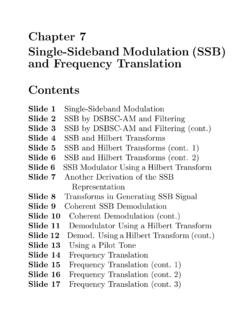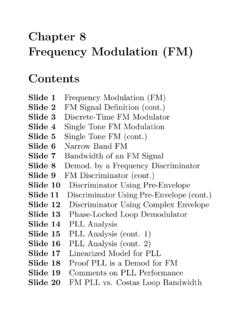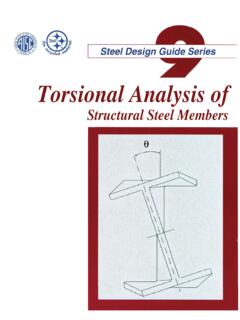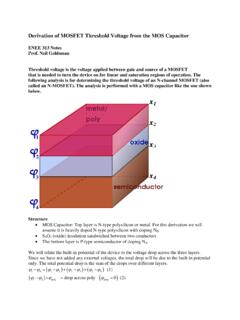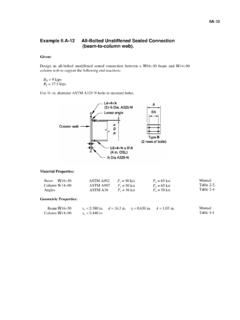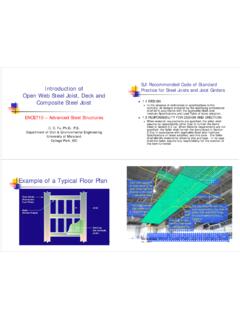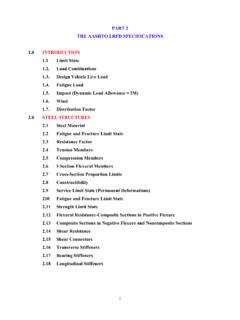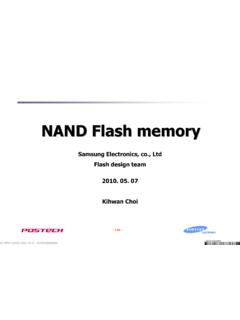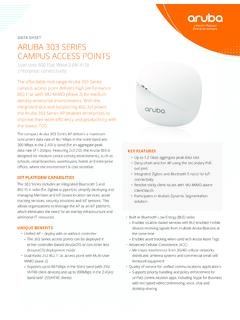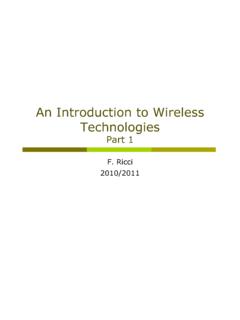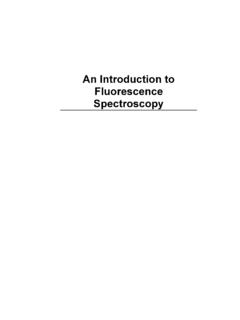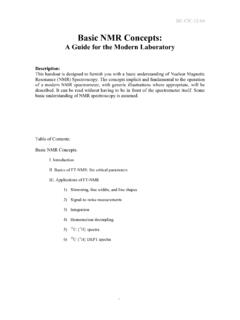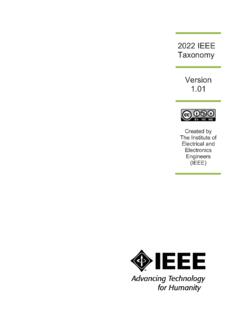Transcription of Chapter 5 Amplitude Modulation Contents - UMD
1 Chapter 5 Amplitude ModulationContentsSlide 1 Amplitude ModulationSlide 2 The Envelope and No OvermodulationSlide 3 Example for Single Tone ModulationSlide 4 Measuring the Modulation IndexSlide 5 Transmitted vs. Message Power ins(t)Slide 6 Powers in Single Tone Case (cont.)Slide 7 spectrum of an AM Signal (cont.)Slide 8 Demodulating by Envelope DetectionSlide 9 Square-Law Envelope Detector (cont.)Slide 10 Sampling Rate for Square-Law DetectorSlide 11 Hilbert Transforms and ComplexEnvelopeSlide 12 Hilbert Transforms (cont.)
2 Slide 13 Pre-Enveope or Analytic SignalSlide 14 spectrum of Pre-EnvelopeSlide 15 Transforms of Pre and Complex EnvelopesSlide 16 Pre-Envelope of AM SignalSlide 17 Envelope Detector Using the HilbertTransformSlide 18 Experiment Making an AMModulatorSlide 19 Experiment (cont. 1)Slide 20 Experiment (cont. 2)Slide 21 Experiment Making a Square-Law Envelope DetectorSlide 22 Experiment Square-Law Detector (cont.)Slide 23 Experiment The Square-LawDetector Output with No Input NoiseSlide 23 Experiment The Square-LawDetector Output with Input NoiseSlide 24 Experiment Square-Law Detectorwith Input NoiseSlide 25 Generating Gaussian RandomNumbersSlide 26 Gaussian RV s (cont.)
3 1)Slide 27 Gaussian RV s (cont. 2)Slide 28 Gaussian RV s (cont. 3)Slide 29 Measuring the Signal PowerSlide 30 Experiment Hilbert TransformExperimentsSlide 31 Experiment Envelope Detector5-iiUsing the Hilbert TransformSlide 32 Experiment Envelope Detector Usingthe Hilbert Transform (cont. 1)Slide 33 Experiment Envelope Detector Usingthe Hilbert Transform (cont. 2)Slide 34 The Delay of the FIR HilbertTransform FilterSlide 35 The Delay of the FIR HilbertTransform Filter(cont. 1)Slide 36 The Delay of the FIR HilbertTransform Filter(cont.
4 2)Slide 37 Transforming a Uniform RandomVariable Into a Desired OneSlide 39 Another SolutionSlide 40 Transforming a Rayleigh RV Intoa Pair of Gaussian RV sSlide 41 Detector Performance with NoiseSlide 43 Square-Law Detector with NoiseSlide 45 Hilbert Detector with NoiseSlide 46 Additional Comments5-iii Chapter 5 Amplitude ModulationAM was the first widespread technique used incommercial radio AM signal has the mathematical forms(t) =Ac[1 +kam(t)] cos ctwhere m(t) is thebaseband message. c(t) =Accos ctis called thecarrierwave.
5 The carrier frequency ,fc, should be largerthan the highest spectral component inm(t). The parameterkais a positive constant calledtheamplitude sensitivityof the The Envelope and NoOvermodulation e(t) =Ac|1 +kam(t)|is called theenvelopeofthe AM signal. Whenfcis large relative tothe bandwidth ofm(t), the envelope is asmooth signal that passes through thepositive peaks ofs(t) and it can be viewed asmodulating(changing) the Amplitude of thecarrier wave in a way related tom(t).Condition for No OvermodulationIn standard AM broadcasting, the envelopeshould be positive, soe(t) =Ac[1 +kam(t)] 0 for alltThenm(t) can be recovered from the envelope towithin a scale factor and constant offset.
6 Anenvelope detector is called anoncoherentdemodulator because it makes no use of thecarrier phase and Example for Single Tone ModulationLetm(t) =Amcos mt. Thens(t) =Ac(1 + cos mt) cos ctwhere =kaAmis called themodulation 1 Time t /TmExample with = and c= 10 m5-3 Measuring the Modulation Index forthe Single Tone CaseFor 0 1, the envelope has the maximumvalueemax=Ac(1 + )and minimum valueemin=Ac(1 )Taking the ratio of these two equations andsolving for gives the following formula for easilycomputing the Modulation index from a display ofthe modulated signal.
7 =1 eminemax1 +eminemax5-4 Single Tone Case (cont.)OvermodulationWhen = 1 the AM signal is said to be 100%modulated and the envelope periodically reaches0. The signal is said to beovermodulatedwhen > vs. Message Power ins(t)The transmitted signal can be expressed ass(t) =Accos ct+ cos( c+ m)t+ cos( c m)t The first term is a sinusoid at the carrierfrequency and carries no message information. The other two terms are calledsidebandsandcarry the information inm(t).5-5 Power Relations for Single ToneCase (cont.)The total power ins(t) isPs= + 2while the power in the sidebands due to themessage isPm= 2and their ratio is =PmPs= 22 + 2 This ratio increases monotonically from 0 to 1/3as increases from 0 to 1.
8 Since the carriercomponent carries no message information, themodulation is most efficient for 100% The spectrum of an AM SignalSuppose the baseband messagem(t) has a FouriertransformM( ) andM( ) = 0 for| | Wand c> W. ThenS( ) =Ac ( + c) +Ac ( c)+Ac2kaM( + c) +Ac2kaM( c) W0WM( ) 0 c c c+W c W c W c+WS( ) Ac Ac Ac2kaM( c) Ac2kaM( + c)(a) Fourier Transform of Baseband Signal(b) Fourier Transform of Transmitted AM Signal5-7 Demodulating an AM Signal byEnvelope DetectionMethod 1.
9 Square-Law Demodulation LowpassFilters(t)( )2H( )p( )y(t)Square-Law Envelope Detectors(t) =Ac[1 +kam(t)] cos ctThe baseband messagem(t) is a lowpass signalwith cutoff frequencyW, that is,M( ) = 0 for| | squarer output iss2(t) =A2c[1 +kam(t)]2cos2 ct= [1 +kam(t)]2+ [1 +kam(t)]2cos 2 ct5-8 Square-Law Envelope Detector (cont.) The first term on the right-hand side is alowpass signal except that the cutofffrequency has been increased to 2 Wby thesquaring operation. The second term has a spectrum centeredabout 2 c.
10 For positive frequencies, thisspectrum is confined to the interval(2 c 2W,2 c+ 2W). The spectra for these two terms must notoverlap. This requirement is met if2W <2 c 2 Wor c>2W H( ) is an ideal lowpass filter with cutofffrequency 2 Wso that its output [1 +kam(t)]2. The square-rooter output is proportional tom(t) with a dc Required Sampling Rate for Square-LawDemodulator s2(t) is band limited with upper cutofffrequency 2( c+W). Therefore,s(t) must besampled at a rate of at least 4( c+W) toprevent aliasing. The lowpass filterH( ) must operate onsamples ofs2(t) taken at the rate 4( c+W).
